Kawasaki Launches the Smartphone-Capable 2019 Ninja H2 and Ninja H2 Carbon and the Newly Optimized 2019 Ninja H2R
Aug. 10, 2018

Tokyo, August 10, 2018—Kawasaki Heavy Industries, Ltd. announced today that it is launching new and improved 2019 models of its flagship motorcycles the Ninja H2 and Ninja H2 Carbon.*1 They will be released in select markets starting August 10, 2018. In addition, it is launching the 2019 model of the track-only Ninja H2R, more fully featured than ever. It will likewise be released in select markets starting August 10, 2018.
All three are supreme hyper-performance sport models developed to prove the collective strength of Kawasaki Group technology, where engines supercharged by a Kawasaki-made supercharger enable for acceleration beyond belief.
Followings are some of the changes from the previous models.
2019 Ninja H2 and Ninja H2 Carbon
Engine
| Supercharged engine perfected to greater heights The 998cm3, liquid-cooled, four-stroke inline four-cylinder supercharged engine has improved efficiency thanks to the application of know-how from the development of the balanced supercharged engine of the highly fuel-efficient Ninja H2 SX. Major components such as the air filter, intake chamber, and spark plug derive directly from the H2 SX to achieve 231 PS. |
Chassis
| 1. | Brembo Stylema monobloc caliper From the street monobloc caliper lineup of Italy’s Brembo, Kawasaki chose the latest and greatest, the Stylema, for the front brake. The Stylema is smaller and lighter than its predecessor, the M50, while also improving braking performance. |
| 2. | Latest Bridgestone tires Bridgestone’s brand-new Battlax Racing Street RS11 tires make handling nimbler than ever. |
Equipment
| 1. | Kawasaki introduces its first smartphone connectivity feature The new models support two-way Bluetooth communication with smartphones. The dedicated smartphone application “RIDEOLOGY THE APP” allows riders, for example, to check vehicle information and routes on the smartphone and show incoming calls and emails on an LCD screen on the instrument panel. |
| 2. | Full-color TFT LCD screen displays diverse information functionally The instrument panel uses a full-color thin-film-transistor (TFT) LCD screen to display information functionally. It has a scrollable multifunction window and four selectable display modes. Riders can visually display needed information according to the riding conditions and their preferences, including supercharger boost pressure, throttle position, braking efficiency, and linear acceleration. The screen also adjusts its brightness automatically in response to ambient brightness for high visibility. |
| 3. | Highly Durable Paint repairs itself*2 The new Highly Durable Paint has a special top coat that automatically repairs scratches to preserve the vehicle’s high-quality appearance. |
| 4. | Lighting goes all-LED Now the number lights are LED. With the existing LED headlamp, tail lamp, and indicators, this makes all the lamps on the vehicle LED. |
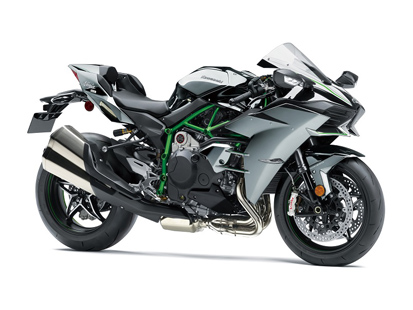
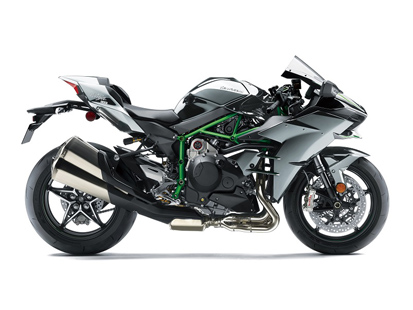
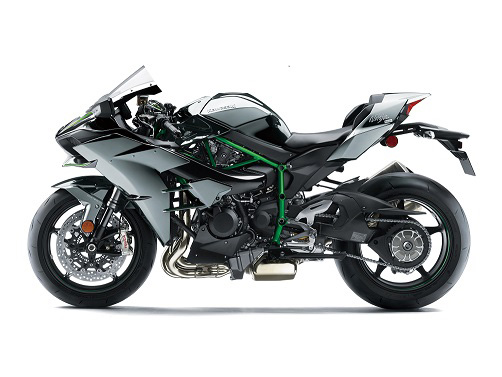

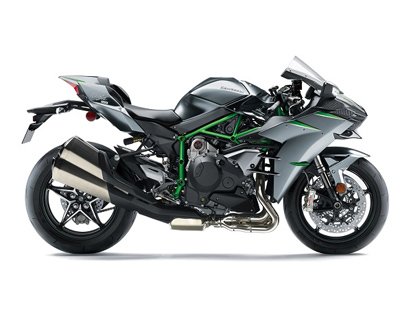
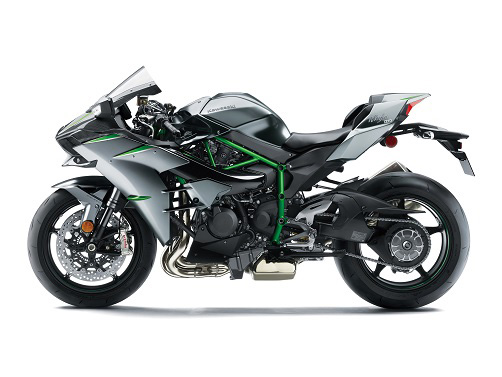
2019 Ninja H2R
Chassis
| Brembo Stylema monobloc caliper From the street monobloc caliper lineup of Italy’s Brembo, Kawasaki chose the latest and greatest, the Stylema, for the front brake. The Stylema is smaller and lighter than its predecessor, the M50, while also improving braking performance. |


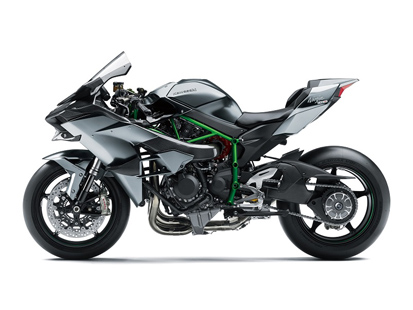
Team 38, an independent racing team made up of Kawasaki engineers and test riders, will be in the United States with the Ninja H2 to compete in this year’s Bonneville Speed Week motorsports event held at the Bonneville Salt Flats from August 11th through 17th, where they will enter the P-PB 1000 class.*3 The well-recognized event, where motorcars and motorcycles gather to challenge world speed records, has a history stretching back more than 100 years. Kawasaki first entered the event in 1967 with the A1R*4 and broke existing world records in two classes. After 51 years, Kawasaki aims to set a world speed record again.
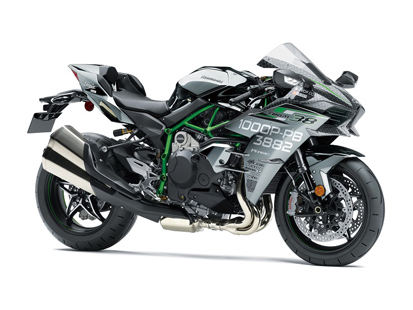
| *1: | The Ninja H2 Carbon uses a carbon fiber reinforced polymer (CFRP) upper cowl for light weight and high strength. Its front region is modeled after the Ninja H2R to inspire a superior sense of sophistication and quality. |
| *2: | In some cases, the coating takes more than one week for recovery. The paint will not recover in the case of scratches caused by a coin or key, or zip fasteners. |
| *3: | Class for production models with supercharged engines up to 1000cc |
| *4: | Two-stroke 250cc road racer launched in 1966 |
| Product names | Ninja H2, Ninja H2 Carbon, Ninja H2R | |
| Launch dates | Starting August 10, 2018 | |
| Region of release | Europe, United States, Canada, Australia, Japan, Indonesia, Thailand, Philippines, more | |
| Colors | Mirror Coated Spark Black (Ninja H2) Mirror Coated Matte Spark Black/Golden Blazed Green (Ninja H2 Carbon) Mirror Coated Matte Spark Black (Ninja H2R |
|
| * | The The Ninja H2R cannot be operated on public roads or with general traffic. Also, license plates cannot be obtained for the Ninja H2R. |
| * | As a track-only model, the Ninja H2R is not eligible for the warranty on general vehicles. |
Main specifications
| Ninja H2, Ninja H2 Carbon | ||||
|---|---|---|---|---|
| Product names | Ninja H2, Ninja H2 Carbon | |||
| Model | ZX1002JKF | |||
| Length × width × height | 2,085mm x 770 mm x 1,125 mm | |||
| Wheelbase | 1,455 mm | |||
| Min. ground clearance | 130 mm | |||
| Seat height | 825 mm | |||
| Caster/trail | 24.5°/103 mm | |||
| Engine type/valve system | Liquid-cooled 4-stroke, 4-cylinder/DOHC 4-valve | |||
| Total displacement | 998 cm3 | |||
| Inner diameter x stroke | 76.0 x 55.0 mm | |||
| Compression ratio | 8.5:1 | |||
| Starting system | Self-starter | |||
| Ignition system | Battery and coil (transistor ignition) | |||
| Lubrication system | Wet sump | |||
| Engine oil capacity | 5.0 L | |||
| Fuel supply system | Fuel injection | |||
| Transmission type | Constant mesh 6-speed return shift | |||
| Clutch type | Multiplate wet clutch | |||
| Gear ratios | 1st | 3.188 (51/16) | ||
| 2nd | 2.526 (48/19) | |||
| 3rd | 2.045 (45/22) | |||
| 4th | 1.727 (38/22) | |||
| 5th | 1.524 (32/21) | |||
| 6th | 1.348 (31/23) | |||
| Primary reduction ratio / secondary reduction ratio | 1.551 (76/49) / 2.444 (44/18) | |||
| Frame type | Trellis | |||
| Suspension system | Front | Telescopic (inverted) | ||
| Rear | Swingarm (new Uni-Trak) | |||
| Tire size | Front | 120/70 ZR17M/C 58W | ||
| Rear | 200/55 ZR17M/C 78W | |||
| Brake type | Front | Dual disk 330 mm (outer diameter) | ||
| Rear | Single disk 250 mm (outer diameter) | |||
| Steering angle (left/right) | 27°/27° | |||
| Vehicle weight | 238 kg | |||
| Fuel tank capacity | 17 L | |||
| * | Numbers are overseas specifications. |
| * | Specifications may change without notice. |
| * | Reference values measured by Kawasaki under specific conditions, not a guarantee of output for purchased vehicles. |
| Ninja H2R | ||||
|---|---|---|---|---|
| Product names | Ninja H2R | |||
| Model | ZX1000YKF | |||
| Length × width × height | 2,070 mm x 850 mm x 1,160 mm | |||
| Wheelbase | 1,450 mm | |||
| Min. ground clearance | 130 mm | |||
| Seat height | 830 mm | |||
| Caster/trail | 25.1°/108 mm | |||
| Engine type/valve system | Liquid-cooled 4-stroke, 4-cylinder/DOHC 4-valve | |||
| Total displacement | 998 cm3 | |||
| Inner diameter x stroke | 76.0 x 55.0 mm | |||
| Compression ratio | 8.3:1 | |||
| Starting system | Self-starter | |||
| Ignition system | Battery and coil (transistor ignition) | |||
| Lubrication system | Wet sump | |||
| Engine oil capacity | 5.0 L | |||
| Fuel supply system | Fuel injection | |||
| Transmission type | Constant mesh 6-speed return shift | |||
| Clutch type | Multiplate wet clutch | |||
| Gear ratios | 1st | 3.188 (51/16) | ||
| 2nd | 2.526 (48/19) | |||
| 3rd | 2.045 (45/22) | |||
| 4th | 1.727 (38/22) | |||
| 5th | 1.524 (32/21) | |||
| 6th | 1.348 (31/23) | |||
| Primary reduction ratio / secondary | 1.551 (76/49) / 2.333 (42/18) | |||
| Frame type | Trellis | |||
| Suspension system | Front | Telescopic (inverted) | ||
| Rear | Swingarm (new Uni-Trak) | |||
| Tire size | Front | 120/600 R17 | ||
| Rear | 190/650 R17 | |||
| Brake type | Front | Dual disk 330 mm (outer diameter) | ||
| Rear | Single disk 250 mm (outer diameter) | |||
| Steering angle (left/right) | 27°/27° | |||
| Vehicle weight | 216 kg | |||
| Fuel tank capacity | 17 L | |||
| * | Numbers are overseas specifications. |
| * | Specifications may change without notice. |
| * | Reference values measured by Kawasaki under specific conditions, not a guarantee of output for purchased vehicles. |
Contact
If you need more information about our business,
please feel free to contact us.





